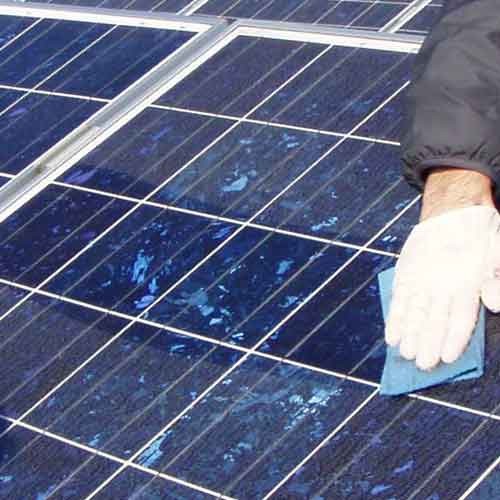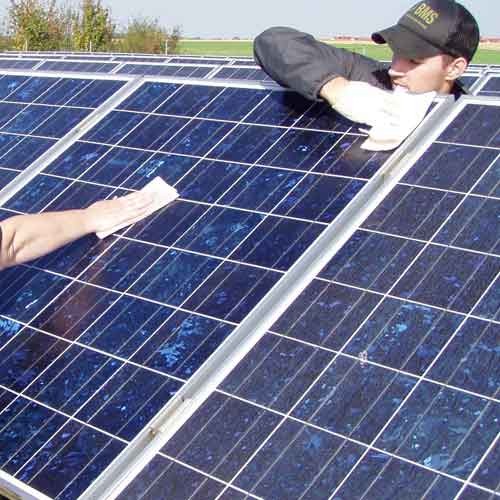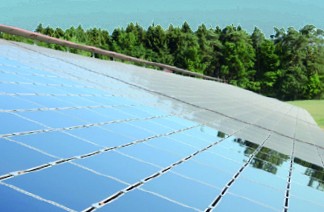Cleaner with nano coating for photovoltaic and solar systems
Nanotol cleans and smoothes the surface of solar and photovoltaic modules
As a result, the modules stay clean longer, need to be cleaned less often and have a higher efficiency for many years.
Cleaner with nano coating for photovaltaic and solar systems
Nanotol cleans and smoothes the surface of solar and photovoltaic modules
As a result, the modules stay clean longer, need to be cleaned less often and have a higher efficiency for many years.
Cleaning and nano coating for photovoltaic and solar systems
Nanotol cleans and seals the surface of solar systems and photovoltaic modules. The smoother surface makes it harder for dirt to adhere. Running rain simply takes dust with it. Only clean modules produce the maximum amount of energy because they can capture more sunlight. Any contamination reduces this yield and causes performance losses of up to 50%. For many years, Nanotol has inspired thousands of customers who use the do-it-yourself method to protect their PV and solar modules from dirt and aging. You don't need a professional to do this and you can save a lot of money if you do it yourself. Nanotol Solar convinces with its easy application and long durability.
Ensure maximum yield!




Many thanks to dr. Gerd Horner for permission to use these video recordings:
The panels were installed in Spain and were extremely contaminated by seagull and pigeon droppings. Before the application of Nanotol Solar 1+2, several approaches of these animals were observed several times a day. After applying Nanotol Solar 1+2 there was not a single landing.
The panels are correspondingly clean.

Nanotol Solar 1+2



Sufficient for about 160 square meters
Sufficient for about 800 square meters
Sufficient for about 4000 square meters

Suitable for
- Solar modules incl. frame
- Photovoltaic systems
- Solar roofs
- Solar garages
A product to increase efficiency!
Nanotol nano-coated solar modules have an extended service life because increased power is still available after many years.
Easy to use
- You do not need a professional for coating - do it yourself
- Detailed instructions enclosed
- Inexpensive care products for refreshing
Ideal application when the surfaces are already wet from rain.
less dirt
Windows stay clean longer.
Nanotol fills the pores of the glass surface and smoothes it perceptibly. Dirt therefore adheres less and can be washed off by rain.
easy cleaning
Easy-to-clean surface.
Dirt no longer bonds with the surface and can be removed very quickly and easily. You save a lot of time due to the non-stick effect.
Cleaning just with water
You only need water for cleaning.
Surfaces coated with Nanotol can be cleaned without cleaning agents. Dirt is simply removed with demineralised water.
The effect lasts for many years
One-time basic nano coating.
After the one-time basic coating, the effect lasts for 2-3 years. Refreshing and prolonging the Nanotol effect is quick and easy with Nanotol 1+2.
It's so easy to nano coat your photovoltaic and solar modules with Nanotol
Nanotol Solar 1+2 is a combination of cleaner and nano sealing for all surfaces on the modules. Seal not only the glass surface, but also the frame so that it also repels dirt and is easier to clean when it rains.
Process of the Nanotol basic sealing:
- Wet the surface with demineralized water
- Spray on Nanotol Solar 1+2 and distribute the liquid with a cloth
- Rinse off dirt and cleaner with deionized water. The nanopolymers remain in the pores.
Repeat the process if the modules are heavily soiled.
If you do not have or cannot use demineralized water, you must dry the modules with a microfiber cloth so that no limescale remains on the surface.

Clean the modules by hand if accessible
Cleaning with a telescopic rod for moduls that are difficult to reach


Apply Nanotol nano coating with a cloth or also with a telescopic rod

If possible, do not use tap water containing lime when cleaning, or dry the modules carefully to avoid water stains.

In future, your modules will be protected against dirt...

...and rain washes away loose dirt.



More areas of applications for Nanotol Household
Glass Coating
Class cabinets, glass tables and furniture look more valuable when they are clean. Nano coating with Nanotol Household makes surfaces antistatic and thus repels dust. You will notice less dusting, smudges and fingerprints can quickly be removed with a dry cloth.
- Antistatic and dust repellent
- Crystal glass effect and high quality appearance
- All surfaces are sustainably protected
- Fast cleaning without detergents


Nano coat the worktop with Nanotol
The worktop in the kitchen is probably the most cleaned surface in the household. Everyone wants hygienically clean conditions when preparing food. Work surfaces coated with Nanotol are so dirt-repellent that they can be proven to be hygienically clean simply by wiping with water.
- Nanotol is permanently temperature-resistant up to 200 °C and is therefore also suitable for the hob or ceramic hob
- Refresh once a week with Nanotol Household 2in1
- Quick cleaning just with water

Coating windows and conservatories with Nanotol
Surfaces coated with Nanotol can be cleaned without cleaning agents. Dirt is simply removed with a damp cloth and the glass and frame are dried with a microfibre cloth.
- 50% less cleaning
- 80% faster cleaning
- 90% less cleaning agents
General questions about Nanotol
How long does the Nanotol nano-coating last on the solar panel?
The basic nano-coating with Nanotol lasts for several years. Depending on the load on the surface (location of the solar system), this is between 3 and 8 years.
Afterwards, you can easily and quickly refresh the coating with Nanotol 1+2 by cleaning the panels with Nanotol 1+2. Spray on the surface, spread, rinse off - done. This refresher will then last for another 2-3 years.
How long does the Nanotol nano-coating last on the solar panel?
The basic nano-coating with Nanotol lasts for several years. Depending on the load on the surface (location of the solar system), this is between 3 and 8 years.
Afterwards, you can easily and quickly refresh the coating with Nanotol 1+2 by cleaning the panels with Nanotol 1+2. Spray on the surface, spread, rinse off - done. This refresher will then last for another 2-3 years.
Can you also pre-clean with another cleaner?
Nanotol Protector can only attach evenly if there are no residues on the surface that could cause chemical interference. These can be caused, for example, by anionic surfactants contained in other cleaning agents or solvents in glass cleaners.
Nanotol Cleaner is perfectly matched to Nanotol Protector and contains very high-quality non-ionic surfactants. The cleaning result is better than with conventional standard cleaning agents. For best results, we recommend to use the Nanotol Cleaner of the appropriate category. Note: Nanotol Cleaners are all different!
How often do you have to clean the solar system after Nanotol nano-coating?
It depends a bit on the location, i.e. whether the solar system is on a busy road. Rain washes away a large part of the dirt. You can therefore approximately halve the frequency required before coating.
Does pollution reduce the yield of a photovoltaic system?
The more dirt there is on the modules, the less sunlight reaches the silicon cells. Firm dirt acts like shadows and significantly impairs performance. No sunlight can be converted into electricity at the polluted places.
This significantly reduces the efficiency and yield of the system.
Should coarse dirt be removed with another cleaning agent before using the Nanotol set?
Quite clearly, no. You can and should start right away with Nanotol Cleaner Step 1, because the Cleaner dissolves the dirt so that you can remove it more easily and not damage the solar panels in the process.
The best thing to do is to wet the solar panel, spray on Nanotol Cleaner 1 (with the ready-to-use bottle), spread it out and let it soak for a little while (about 30 seconds) so that the chemistry can work. After that, dirt simply disappears.
How often does a photovoltaic system have to be cleaned?
How often a photovoltaic system has to be cleaned depends on the location. In the vicinity of farms or next to the highway, there is usually more dirt that requires annual cleaning. In residential areas, it is sufficient to clean the modules every two to three years. The more frequently cleaning is done, the easier and faster cleaning can be done.
Which water is used for PV cleaning?
Demineralized, fully desalinated water is the method of choice: the professional cleaning of a photovoltaic system requires the use of demineralized, fully desalinated water.
With normal tap water, limescale residues remain on the surface, which can lead to reduced performance.
How much does it cost to clean a photovoltaic system?
The cost of cleaning a photovoltaic system can vary depending on various factors. These include the size of the system, the accessibility of the modules, the type of soiling, the local conditions and the prices of the respective cleaning company or service provider.
Normally, photovoltaic systems are cleaned at regular intervals to ensure maximum energy yield. With Nanotol coating, these distances can be significantly increased.
Prices can be calculated either per square meter of the facility or as a flat rate. As a rough guide, the cost of cleaning a photovoltaic system can range from €0.10 to €0.50 per square meter.
It is important to note that regular cleaning of the system can optimize energy production and extend the life of the modules. Investing in cleaning can therefore pay off in the long run by ensuring the facility is operating efficiently and delivering the maximum yield. Cleaning and nano coating with Nanotol can also optimize energy production and extend service life.
